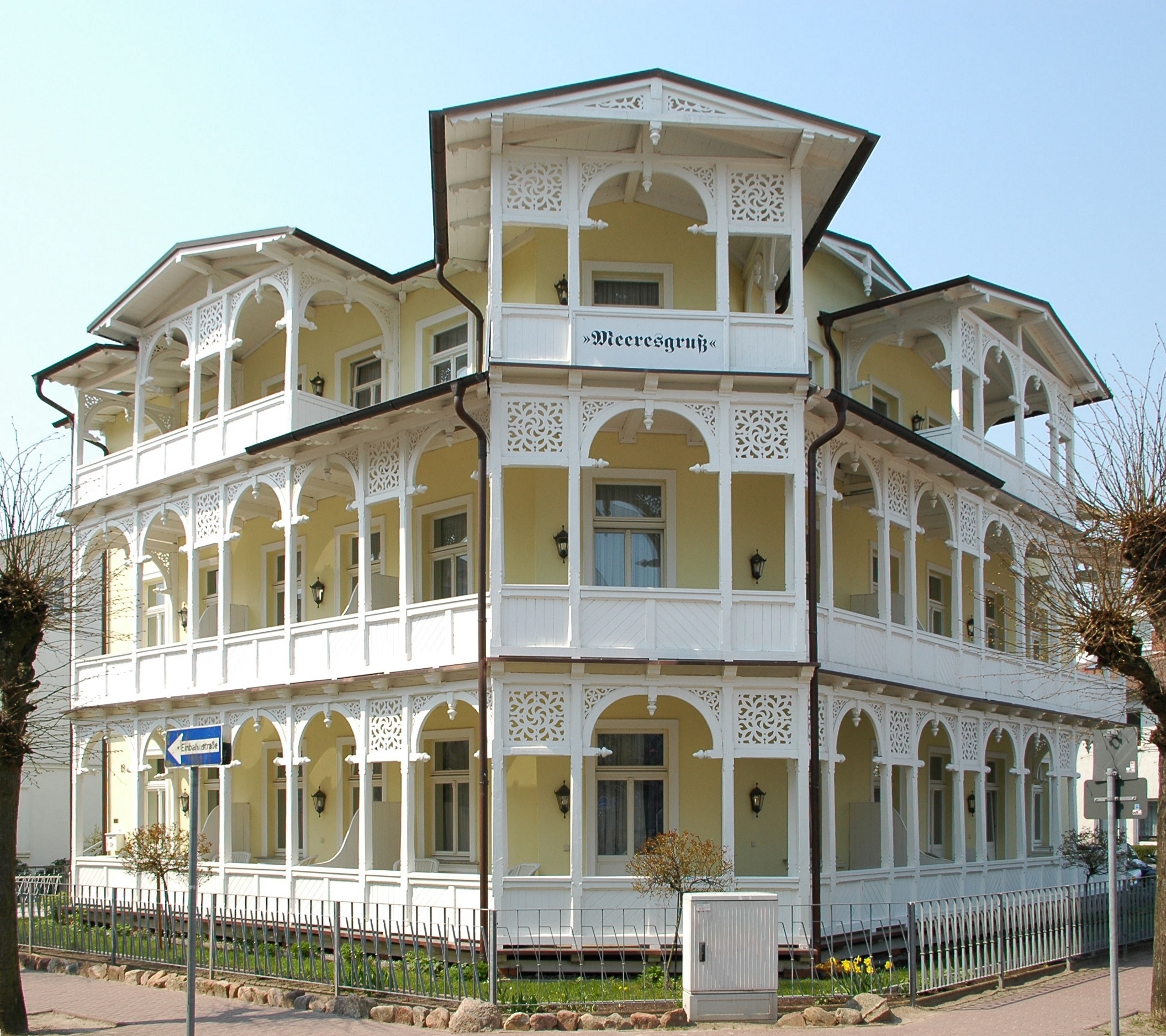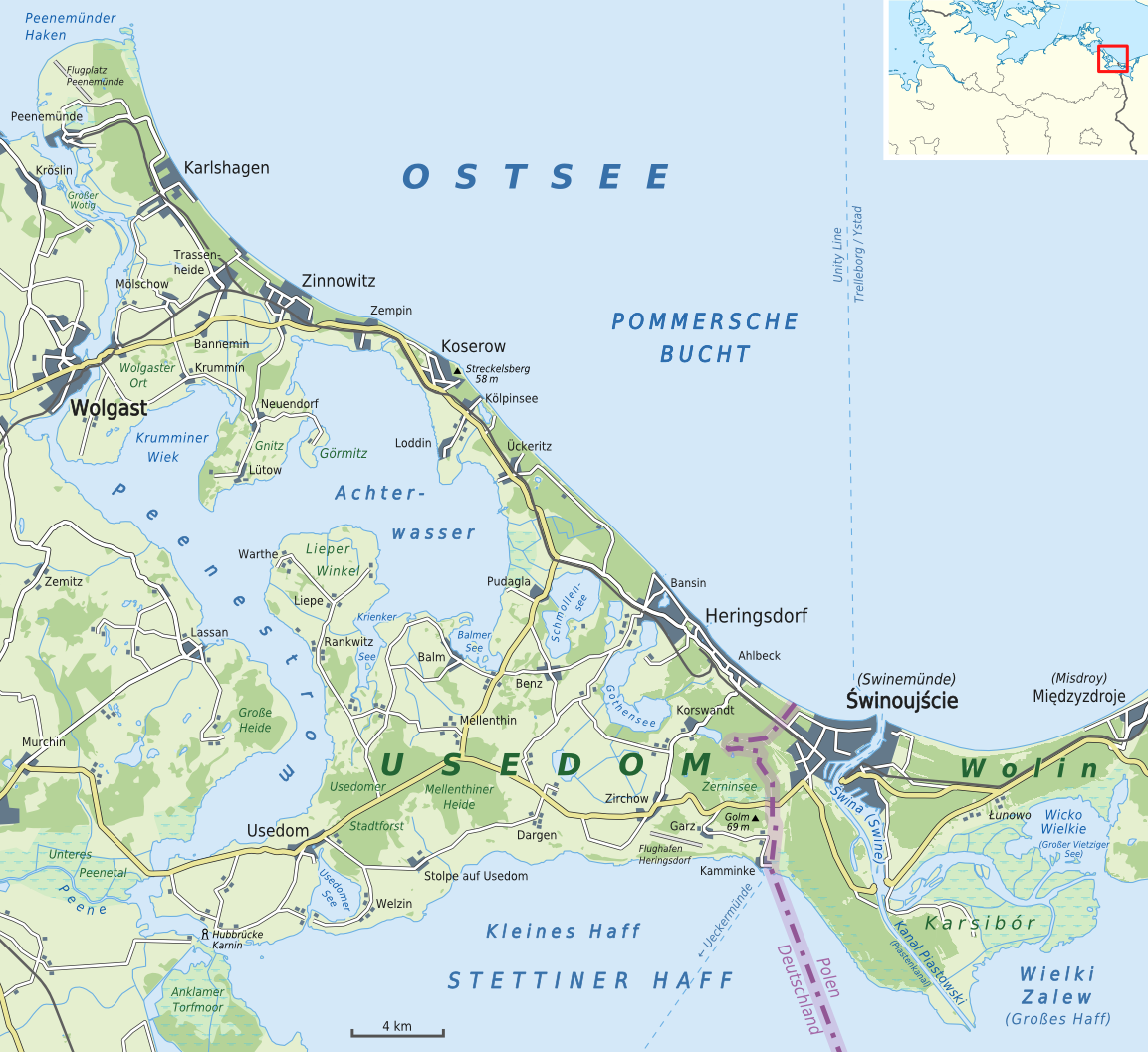|
Bäderarchitektur
Resort architecture () is an architectural style that is especially characteristic of spas and seaside resorts on the German Baltic coast. The style evolved since the foundation of Heiligendamm in 1793, and flourished especially around the year 1870, when resorts were connected to big cities via railway lines. Until today, many buildings on the German coasts are built in the style or feature distinct elements of resort architecture. Single free-standing mansions featuring resort architecture are called ''Bädervilla'' (plural ''Bädervillen''), translating as Resort Mansion or Spa Villa. The architecture of inland health spas in Central Europe (i.e. those away from the coast), in Thuringia, the Czech Republic or Switzerland for instance, is generally referred to as spa architecture (''Kurarchitektur''). History The architectural style of resort architecture was initially developed since the foundation of Heiligendamm in Mecklenburg in 1793, the first continental European seasid ... [...More Info...] [...Related Items...] OR: [Wikipedia] [Google] [Baidu] |
Heringsdorf
Heringsdorf is a semi-urban municipality and a popular seaside resort on Usedom Island in Western Pomerania, Germany. It is also known by the name Kaiserbad ('). The municipality was formed in January 2005 out of the former municipalities of Heringsdorf, Ahlbeck and Bansin. Until January 2006, the municipality was called ''Dreikaiserbäder'', literally meaning ''Three Imperial Spas'', a reference to several vacation visits of the German emperor Wilhelm II until 1918. For the same reason, the fine sandy beach stretching about from Bansin over Heringsdorf to Ahlbeck and Swinemünde (nowadays a Polish spa), is also called ''Kaiserstrand'' (Imperial Beach). The continuous Baltic Sea beach of Usedom Island has an overall length of exactly and an average width of . Tourism is the dominant economic sector of the Imperial Spas, with an increasing number of hotels and vacation homes every year. Overview Heringsdorf is located on the Baltic Sea coast of the island of Usedom, ... [...More Info...] [...Related Items...] OR: [Wikipedia] [Google] [Baidu] |
Spa Architecture
Spa architecture () is the name given to buildings that provide facilities for relaxation, recuperation and health treatment in spas. The architecture of these buildings is called "spa architecture" even though it is not a uniform architectural style, but a collective term for a genre of buildings with a spa function. This type of building first appeared in Europe in the 17th century and had its heyday in the 19th century. The term spa architecture relates especially to buildings in the healing spas inland; those on the coast, the seaside resorts, developed their own resort architecture (German: ''Bäderarchitektur''). However, since the early 19th century there have been many parallels of architectonic expression between inland spas and coastal resort spas. Early predecessors in antiquity and the Middle Ages There were spas even in classical antiquity. They owed their emergence to the healing properties of hot springs which were already known at that time. In the centre of Roman ... [...More Info...] [...Related Items...] OR: [Wikipedia] [Google] [Baidu] |
Historicism (art)
Historicism or historism comprises artistic styles that draw their inspiration from recreating historic styles or imitating the work of historic artists and artisans. Lucie-Smith, Edward. ''The Thames and Hudson Dictionary of Art Terms''. London: Thames & Hudson, 1988, p. 100. This is especially common in architecture, where there are many different styles of Revival architecture, which dominated large buildings in the 19th century. Through a combination of different styles or the implementation of new elements, historicism can create completely different aesthetics than former styles. Thus, it offers a great variety of possible designs. Overview In the history of art, after Neoclassicism which in the Romantic era could itself be considered a historicist movement, the 19th century included a new historicist phase characterized by an interpretation not only of Greek and Roman classicism, but also of succeeding stylistic eras, which were increasingly respected. In particular ... [...More Info...] [...Related Items...] OR: [Wikipedia] [Google] [Baidu] |
Veranda
A veranda (also spelled verandah in Australian and New Zealand English) is a roofed, open-air hallway or porch, attached to the outside of a building. A veranda is often partly enclosed by a railing and frequently extends across the front and sides of the structure. Although the form ''verandah'' is correct and very common, some authorities prefer the version without an "h" (the ''Concise Oxford English Dictionary'' gives the "h" version as a variant and '' The Guardian Style Guide'' says "veranda not verandah"). Australia's ''Macquarie Dictionary'' prefers ''verandah''. Etymology ''Veranda'', as used in the United Kingdom and France, was brought by the British from India (, ). While the exact origin of the word is unknown, scholars suggest that the word may have originated in India or may have been adopted from the Portuguese and spread further to the British and French colonists. Ancient and medieval Indian texts on domestic architecture like Vastu shastra uses the word ... [...More Info...] [...Related Items...] OR: [Wikipedia] [Google] [Baidu] |
Kühlungsborn
Kühlungsborn () is a Seebad (seaside resort) town in the Rostock district, in Mecklenburg-Vorpommern, Germany. It is situated on the Baltic Sea coast, 11 km northwest of Bad Doberan, and 25 km northwest of Rostock. The town has an elongate beach and promenade, many hotels in typical German spa town architecture and a marina. It is the largest seaside spa town in Mecklenburg. Kühlungsborn is a place with long spa traditions. It was one of the early seaside resorts to be founded in Germany, dating back to the 1860s. While the bicycle is a popular way of transport, the Molli steam railway is a historic tourist attraction that also allows exploration the area. In summer, many people rent of the traditional Strandkorb on the beach, a covered chair protecting one from wind and sun. Town history The town of Kühlungsborn was founded on April 1, 1938 with the merger of the three municipalities; Fulgen, Brunshaupten and Arendsee. On the town coat of arms, three flying seag ... [...More Info...] [...Related Items...] OR: [Wikipedia] [Google] [Baidu] |
Usedom
Usedom ( , ) is a Baltic Sea island in Pomerania, divided between Germany and Poland. It is the second largest Pomeranian island after Rügen, and the most populous island in the Baltic Sea. It lies north of the Szczecin Lagoon estuary of the Oder river. About 80% of the island belongs to the German district of Vorpommern-Greifswald in the state of Mecklenburg-Vorpommern. The eastern part and the largest city on the island, Świnoujście, are part of the Polish West Pomeranian Voivodeship. The island's total area is – in the German part and in the Polish part. Its population is 76,500 (German part 31,500; Polish part 45,000). With an annual average of 1,906 hours of sunshine, Usedom is the sunniest region of both Germany and Poland, and it is also one of the sunniest islands in the Baltic Sea, hence its nickname "Sun Island" (, ). The island has been a tourist destination since the Gründerzeit in the 19th century, and features resort architecture. Seaside resorts inc ... [...More Info...] [...Related Items...] OR: [Wikipedia] [Google] [Baidu] |
Bad Doberan
Bad Doberan () is a town in the district of Rostock, Mecklenburg-Vorpommern, Germany. It was the capital of the former district of Bad Doberan. In 2012, its population was 11,427. Geography Bad Doberan is situated just west of Rostock's city centre and is therefore part of one of the most developed regions in the north-eastern part of Germany. The town nestles between beech tree forests just 6 km from the Baltic Sea and is one of the earliest German settlements in Mecklenburg. Today the town is a very popular bathing resort, thanks to Heiligendamm, a district of Bad Doberan situated directly at the cliff line of the Baltic. Historically, Doberan used to be the summer residence for the Mecklenburg Dukes who resided in Schwerin, and for their entourage. Name The name Doberan, originally ''Dobran'', is a place name that probably derives from a Slavic Old Polabian personal name, meaning "good" (''dobry''). According to legend, the name Doberan originated when the monaster ... [...More Info...] [...Related Items...] OR: [Wikipedia] [Google] [Baidu] |
Göhren (Rügen)
Göhren may refer to the following places: ;Germany * Göhren (Tramm), a village in the municipality Tramm in the district Ludwigslust-Parchim, Mecklenburg-Vorpommern * Göhren, Rügen, a municipality in the district Vorpommern-Rügen, Mecklenburg-Vorpommern * Göhren, Thuringia, a municipality in the district Altenburger Land, Thuringia ;Czech Republic * Klíny, a village in Most District ;See also * , a Kriegsmarine coastal tanker {{geodis ... [...More Info...] [...Related Items...] OR: [Wikipedia] [Google] [Baidu] |
Binz
Binz is the largest seaside resort city on the German island of Rügen. It is situated between the bay of Prorer Wiek and the ''Schmachter See'' (a lake) in the southeast of the island. To the north of Binz stretches the Schmale Heide (the "narrow heath"), a tongue of land which joins the Muttland region of Rügen to the Jasmund peninsula. The land to the south and east of Binz is hilly, reaching a height of over 100 metres above sea level. Binz is known for its well-kept historical resort architecture and natural scenery, close to the Jasmund National Park and its chalk cliffs. Its Polish name is ''Bińce'', as recorded and documented in 1937. Geography Location Binz lies on the eastern coast of the island of Rügen between the bay of Prorer Wiek and the lake of Schmachter See. North of Binz is the Schmale Heide, a neck of land that links the Muttland – Rügen's central region – with the peninsula of Jasmund. East and south of the municipality, the land is r ... [...More Info...] [...Related Items...] OR: [Wikipedia] [Google] [Baidu] |
Sellin
Sellin is a municipality on the Island of Rügen, in Mecklenburg-Vorpommern, Germany. History First mentions of Sellin date to 1295. From 1880 on, the town gained importance as a Baltic Sea spa town. After the '' Wende'' in 1989, the building stock in the village was extensively renovated. In 1992, Sellin Pier was rebuilt and was officially opened on 2 April 1998. Culture and sights ''Wilhelmstraße'', with its houses from the resort architecture period (turn of the 19th and 20th century), runs up to the steep coast, up to 30 metres high - where there is a steep flight of steps or a lift to Sellin Pier or the promenade on the South Beach (''Südstrand''). Sellin has the longest pier on Rügen: 394 metres. Since 1991 the historic centre has been thoroughly renovated as part of a programme of urban development. Other sights are the ''Galerie Hartwich'' in the old fire station (''Feuerwehrhaus''), the Amber Museum with its associated workshop and the ''Gnadenkirche''. The ... [...More Info...] [...Related Items...] OR: [Wikipedia] [Google] [Baidu] |
Rügen
Rügen (; Rani: ''Rȯjana'', ''Rāna''; , ) is Germany's largest island. It is located off the Pomeranian coast in the Baltic Sea and belongs to the state of Mecklenburg-Western Pomerania. The "gateway" to Rügen island is the Hanseatic city of Stralsund, where it is linked to the mainland by road and railway via the Rügen Bridge and Causeway, two routes crossing the two-kilometre-wide Strelasund, a sound of the Baltic Sea. Rügen has a maximum length of (from north to south), a maximum width of in the south and an area of . The coast is characterised by numerous sandy beaches, lagoons () and open bays (), as well as peninsulas and headlands. In June 2011, UNESCO awarded the status of a World Heritage Site to the Jasmund National Park, characterised by vast stands of beeches and chalk cliffs like King's Chair, the main landmark of Rügen island. The island of Rügen is part of the district of Vorpommern-Rügen, with its county seat in Stralsund. The towns on Rüg ... [...More Info...] [...Related Items...] OR: [Wikipedia] [Google] [Baidu] |






